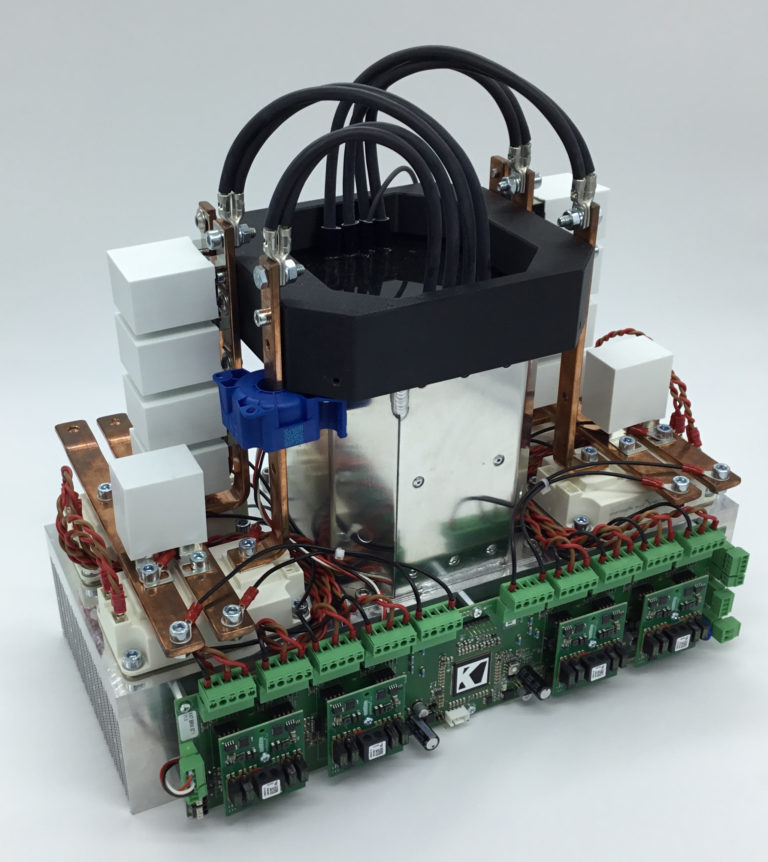Our modular system allows you to put together an optimal system for your power electronics that meets your requirements, from a wide range of existing technologies and solutions. We are experts in controlling various semiconductor technologies such as SiC, GaN, IGBT and Si-MOSFET in power classes ranging from a few 100 W to several 100 kW.
Our modular system includes various power conversion topologies such as AC/DC converters, boost converters, buck converters, bidirectional resonant converters and power controllers, power converters and inverters, as well as drive controllers for a wide range of motor technologies.
This modular system enables rapid development and thus the rapid implementation of your project – 100% tailored to the application. The option of integrating further functionalities on a single assembly creates decisive market advantages for our customers. Our know-how enables us to realize both highly innovative and unbeatable-in-price concepts.
Discover our configurator to put together your individual power electronics solution:

DC/DC resonant converters for galvanic isolation use a resonant circuit, typically consisting of inductors and capacitors, to efficiently transfer energy between the input and output. The circuit operates at a resonant frequency at which losses are minimized. The reduction of switching losses and EMI contributes to a higher overall efficiency of the converter. Compared to conventional PWM-based DC/DC converters, the design of a resonant converter is more complex as the resonance conditions must be precisely tuned. Resonant operation allows higher switching frequencies to be achieved, which leads to a reduction in the size and weight of passive components (such as transformers and filters). The resonant technology also ensures that the voltage and current peaks that occur in conventional switching processes are reduced, resulting in less stress on the components.
The DC/DC converter topologies are fundamental components in the conversion of electrical power.
Similarities and differences between boost/decompression adjusters
Similarities:
Differences:
Combination:
|
|
IGBT Version
|
SiC Version
|
|---|---|---|
|
Input voltage Ue
|
2x 650 VDC 650 VDC – 750 VDC
|
2x 720 VDC 650 VDC – 750 VDC
|
|
Output voltage Ua
|
100 VDC- 1000 VDC 25 VDC- 100 VDC (optional)
|
100 VDC- 1400 VDC 25 VDC- 100 VDC (optional)
|
|
Output current Ia
|
Connection in series 160 A or parallel 320 A
|
Connection in series 350 A or parallel 700 A
|
|
Power
|
100 kW
|
250 kW
|
Can we support you with personal assistance? If so, please call us or send us a message.
Power electronics refers to the conversion, regulation, control, and distribution of electrical energy using semiconductor technology. KNESTEL develops customized power electronic systems, e.g., for DC/DC converters and frequency converters.
KNESTEL offers customized solutions in the field of DC/DC conversion, intelligent power supplies, inverters, and frequency converters for electric motors and actuators.
Unsere Systeme werden in Energiespeichern (BESS), Ladesäulen, Antriebstechnik, Industrieautomation, Medizintechnik, Prüfständen sowie in Smart-Grid-Umgebungen eingesetzt.
Maßgeschneiderte Leistungselektronik passt sich exakt an Systemanforderungen an. Dadurch sind bessere Wirkungsgrade, kompaktere Bauformen und optimierte Schnittstellen möglich. In gezielten Anwendungen sind die Lösungen oftmals sehr kosten-effektiv. Die Entwicklung dieser spezifischen Lösungen erfolgt in relativ kurzen Zeiträumen.
Ja. KNESTEL verfügt über langjährige Erfahrung in der Entwicklung galvanisch isolierter DC/DC-Wandler – mit unterschiedlichen Topologien (Hochsetzsteller und Tiefsetzsteller) für Spannungen bis 1500V. Die DC/DC-Wandler können auch ohne galvanische Isolation aufgebaut werden.
KNESTEL relies on modern power semiconductors such as silicon carbide (SiC) and develops systems based on FPGA, digital signal processors, and microcontrollers for precise control and monitoring.
Yes. KNESTEL implements solutions with outputs of 50 kW, 100 kW, 125 kW, and 250 kW per module. The modules can be set up in parallel for more power and electricity in order to also implement systems in the megawatt range. For example, four 250 kW modules result in 1 megawatt of power.
Yes. In addition to development, KNESTEL also handles series production in-house—including assembly, installation, testing, and test reporting. This means that everything comes from a single source and is made in Germany.
Use the power electronics configurator on our website or call our sales team directly at 08372-7080. We will analyze your requirements and develop a customized solution for your project.